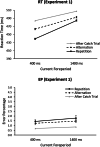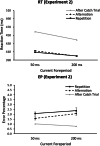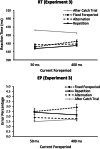Revisiting variable-foreperiod effects: evaluating the repetition priming account
- PMID: 35391659
- PMCID: PMC8989257
- DOI: 10.3758/s13414-022-02476-5
Revisiting variable-foreperiod effects: evaluating the repetition priming account
Abstract
A warning signal preceding an imperative stimulus by a certain foreperiod can accelerate responses (foreperiod effect). When foreperiod is varied within a block, the foreperiod effect on reaction time (RT) is modulated by both the current and the prior foreperiods. Using a non-aging foreperiod distribution in a simple-reaction task, Capizzi et al. (Cognition, 134, 39-49, 2015) found equal sequential effects for different foreperiods, which they credited to repetition priming. The multiple-trace theory of Los et al. (Frontiers in Psychology, 5, Article 1058, 2014) attributes the slope of the foreperiod-RT function to the foreperiod distribution. We conducted three experiments that examined these predicted relations. Experiment 1 tested Capizzi et al.'s prediction in a choice-reaction task and found an increasing foreperiod-RT function but a larger sequential effect at the shorter foreperiod. Experiment 2 used two distinct short foreperiods with the same foreperiod distribution and found a decreasing foreperiod-RT function. By increasing the difference between the foreperiods used in Experiment 2, Experiment 3 yielded a larger sequential effect overall. The experiments provide evidence that, with a non-aging foreperiod distribution, the variable-foreperiod paradigm yields unequal sequential-effect sizes at the different foreperiods, consistent with the multiple-trace theory but contrary to Capizzi et al.'s repetition-priming account. The foreperiod-RT functions are similar to those of the fixed-foreperiod paradigm, which is not predicted by the multiple trace theory.
Keywords: Foreperiod; Non-aging foreperiod distribution; Repetition priming; Variable-foreperiod effect.
© 2022. The Psychonomic Society, Inc.
Figures






Similar articles
-
Change of Variable-Foreperiod Effects within an Experiment: A Bayesian Modeling Approach.J Cogn. 2022 Jul 13;5(1):40. doi: 10.5334/joc.235. eCollection 2022. J Cogn. 2022. PMID: 36072112 Free PMC article.
-
Foreperiod priming in temporal preparation: testing current models of sequential effects.Cognition. 2015 Jan;134:39-49. doi: 10.1016/j.cognition.2014.09.002. Epub 2014 Oct 17. Cognition. 2015. PMID: 25460377
-
Transfer effects in auditory temporal preparation occur using an unfilled but not filled foreperiod.Q J Exp Psychol (Hove). 2021 Aug;74(8):1432-1438. doi: 10.1177/1747021821995452. Epub 2021 Feb 24. Q J Exp Psychol (Hove). 2021. PMID: 33535929 Free PMC article.
-
Self and time in individuals with schizophrenia: A motor component?Schizophr Res. 2024 Oct;272:12-19. doi: 10.1016/j.schres.2024.08.008. Epub 2024 Aug 22. Schizophr Res. 2024. PMID: 39178737 Review.
-
Outlines of a multiple trace theory of temporal preparation.Front Psychol. 2014 Sep 19;5:1058. doi: 10.3389/fpsyg.2014.01058. eCollection 2014. Front Psychol. 2014. PMID: 25285088 Free PMC article. Review.
Cited by
-
Pupillary fluctuation amplitude preceding target presentation is linked to the variable foreperiod effect on reaction time in Psychomotor Vigilance Tasks.PLoS One. 2022 Oct 20;17(10):e0276205. doi: 10.1371/journal.pone.0276205. eCollection 2022. PLoS One. 2022. PMID: 36264952 Free PMC article.
-
The illusion of orientation repulsion is weakened in a temporally more predictable visual target.Atten Percept Psychophys. 2025 May;87(4):1179-1198. doi: 10.3758/s13414-025-03040-7. Epub 2025 Mar 24. Atten Percept Psychophys. 2025. PMID: 40128511 Free PMC article.
-
On doing multi-act arithmetic: A multitrait-multimethod approach of performance dimensions in integrated multitasking.Front Psychol. 2022 Aug 18;13:946626. doi: 10.3389/fpsyg.2022.946626. eCollection 2022. Front Psychol. 2022. PMID: 36059769 Free PMC article.
-
Change of Variable-Foreperiod Effects within an Experiment: A Bayesian Modeling Approach.J Cogn. 2022 Jul 13;5(1):40. doi: 10.5334/joc.235. eCollection 2022. J Cogn. 2022. PMID: 36072112 Free PMC article.
-
No evidence for tactile entrainment of attention.Front Psychol. 2023 May 26;14:1168428. doi: 10.3389/fpsyg.2023.1168428. eCollection 2023. Front Psychol. 2023. PMID: 37303888 Free PMC article.
References
-
- Han, T. (2021). Revisiting Variable-Foreperiod Effects: Evaluating the Repetition Priming Account. Retrieved from osf.io/43g8r. - PMC - PubMed
MeSH terms
LinkOut - more resources
Full Text Sources

